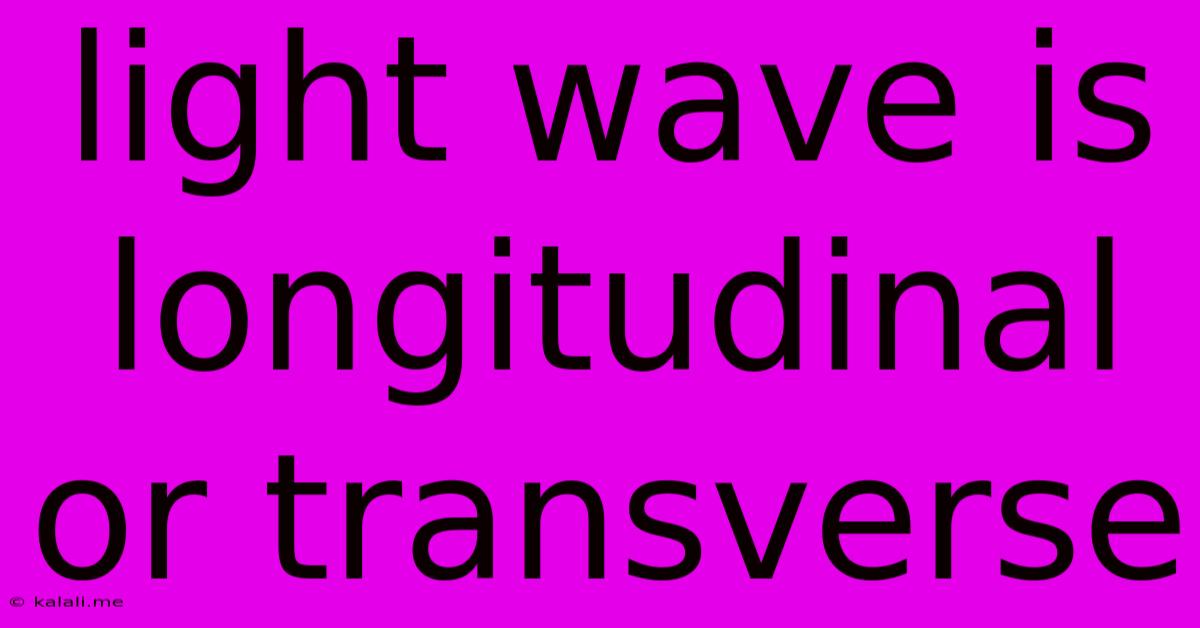Light Wave Is Longitudinal Or Transverse
Kalali
Jun 14, 2025 · 3 min read

Table of Contents
Is Light a Longitudinal or Transverse Wave? Understanding the Nature of Light
Meta Description: Dive deep into the nature of light waves. This article explores whether light is a longitudinal or transverse wave, explaining the key differences and providing a clear understanding of its electromagnetic properties.
Light is a fundamental part of our universe, enabling us to see and interact with the world around us. But what exactly is light? Understanding its nature as a wave is crucial, and a common point of confusion arises when considering whether it's a longitudinal or transverse wave. The simple answer is: light is a transverse wave. Let's delve into why.
Understanding Wave Types: Longitudinal vs. Transverse
Before classifying light, we need to understand the difference between longitudinal and transverse waves. These classifications describe the direction of oscillation relative to the direction of wave propagation.
-
Longitudinal Waves: In longitudinal waves, the particles of the medium vibrate parallel to the direction of wave propagation. Think of a sound wave traveling through air – the air molecules compress and rarefy along the direction the sound is moving. Examples include sound waves and seismic P-waves.
-
Transverse Waves: In transverse waves, the particles of the medium vibrate perpendicular to the direction of wave propagation. Imagine shaking a rope up and down; the wave travels along the rope, but the rope itself moves up and down. Examples include waves on water surfaces and, importantly, light waves.
The Electromagnetic Nature of Light
Light is an electromagnetic wave, meaning it's a self-propagating wave consisting of oscillating electric and magnetic fields. These fields are perpendicular to each other and to the direction of wave propagation. This inherent perpendicularity is the defining characteristic of a transverse wave.
The electric and magnetic fields oscillate in a sinusoidal pattern, creating a wave-like disturbance that travels through space. This doesn't require a medium; light can travel through a vacuum, unlike longitudinal waves which need a medium to propagate.
Why Light Can't Be a Longitudinal Wave
The very nature of electromagnetic waves precludes them from being longitudinal. A longitudinal wave requires a medium to transmit the compression and rarefaction of particles. Since light can travel through a vacuum (as demonstrated by sunlight reaching Earth), it cannot be a longitudinal wave. The oscillation of electric and magnetic fields is intrinsic to the wave itself, not reliant on the movement of particles in a medium.
Polarization: Further Evidence of Light's Transverse Nature
The phenomenon of polarization provides strong evidence for light's transverse nature. Polarization refers to the restriction of the oscillation of the electric field to a single plane. This is only possible with transverse waves; you cannot polarize a longitudinal wave. Polarizing sunglasses, for example, utilize this property to reduce glare by blocking specific orientations of light's electric field.
In Conclusion
In summary, light is definitively a transverse wave. Its electromagnetic nature, ability to travel through a vacuum, and the phenomenon of polarization all confirm this. Understanding this fundamental characteristic of light is vital for comprehending its behavior and applications in various fields of science and technology, including optics, photonics, and telecommunications. The misconception that it might be longitudinal stems from a misunderstanding of the fundamental differences between wave types and the unique properties of electromagnetic radiation.
Latest Posts
Latest Posts
-
Cast Iron Has About How Much Carbon Content
Jun 15, 2025
-
Which Of The Following Are Financial Statements
Jun 15, 2025
-
Which Of The Following Is Not True About Vitamins
Jun 15, 2025
-
Distance Covered Per Unit Of Time
Jun 15, 2025
-
What Is The Gpa Requirement For Lsu
Jun 15, 2025
Related Post
Thank you for visiting our website which covers about Light Wave Is Longitudinal Or Transverse . We hope the information provided has been useful to you. Feel free to contact us if you have any questions or need further assistance. See you next time and don't miss to bookmark.